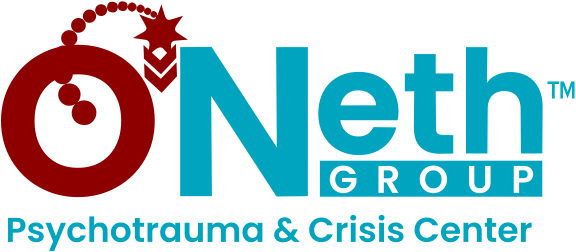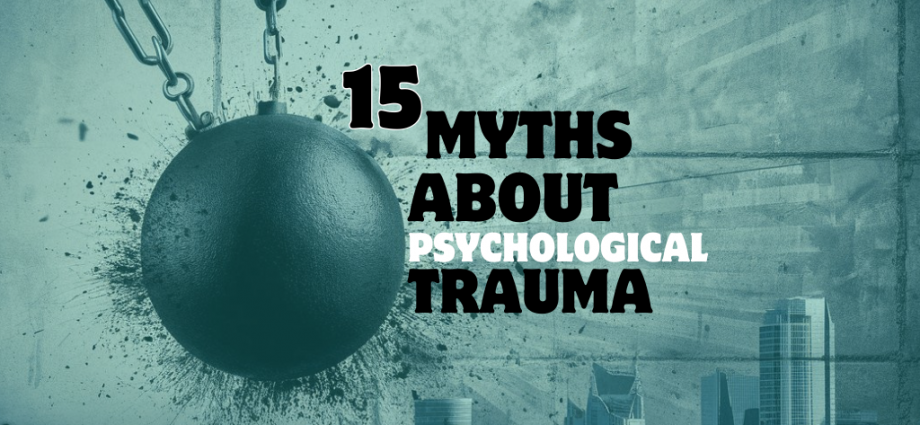Unmasking Misconceptions: 15 Myths Debunked About Psychological Trauma
Trauma: A Complex Topic Shrouded in Misunderstanding
Psychological trauma is a multifaceted issue often clouded by misunderstanding. This can be frustrating for both those who have experienced trauma and mental health professionals. Misconceptions and misinformation can fuel stigma and create barriers for survivors seeking help.
Dispelling Myths for a Clearer Understanding
Whether you’re a mental health professional or someone seeking to better understand trauma, this article aims to be your guide. Let’s debunk some common myths and shed light on the truths about trauma.
Myth #1: Only Major Life Events Cause Trauma
Busted! While war, abuse, and accidents can trigger trauma, seemingly minor incidents can be traumatic too. Our nervous system is wired for survival. When we perceive a threat, our body releases stress hormones to prepare us to fight or flee. Even minor events can overwhelm our nervous system if we perceive them as life-threatening or uncontrollable. For instance, a medical procedure might be perceived as a scary and unpredictable event by a child, leading to a traumatic response. Additionally, individual susceptibility plays a role. People have varying thresholds for what they can handle. A situation that might seem minor to one person could be deeply unsettling to another. This can be due to factors like genetics, past trauma experiences, or existing mental health conditions.
Myth #2: Everyone Reacts to Trauma the Same Way
Busted! Our reactions to trauma are as unique as we are. There are several reasons for this variation:
- Genetic predispositions: Some individuals are genetically more likely to develop post-traumatic stress disorder (PTSD) or other trauma-related symptoms.
- Life experiences: A history of abuse or neglect can make someone more vulnerable to future trauma. On the other hand, strong social support systems can lessen the effects of traumatic events.
- Cultural background: Different cultures have distinct ways of expressing and coping with emotional distress.
Myth #3: Trauma Symptoms Appear Immediately
Busted! Sometimes, symptoms may take weeks, months, or even years to surface. Here’s why:
- The brain needs time to process: The experience of trauma can be overwhelming and confusing for the brain. It may take time for the full impact of the event to be realized, especially in the case of complex or prolonged trauma.
- Coping mechanisms can delay symptoms: Some people cope with trauma by suppressing their emotions or burying the memories. However, these coping mechanisms can eventually break down, leading to the emergence of symptoms.
- Triggers can unlock memories: Certain sights, sounds, smells, or situations can trigger memories of the traumatic event, leading to a sudden onset of symptoms.
Myth #4: Trauma Survivors Are Weak
Busted! Experiencing trauma is a testament to strength and resilience. It takes immense courage to face the emotional and psychological aftermath of a traumatic event.
Trauma: A Normal Reaction to an Abnormal Event
Our brains and bodies are wired to protect us from danger. When we experience trauma, our body’s natural fight-or-flight response is activated to help us survive. Trauma survivors often experience a wide range of emotions. While these emotions can be difficult, they are a normal part of the healing process. It takes immense strength to process these emotions and begin rebuilding one’s life.
Myth #5: Talking About Trauma Makes It Worse
Busted! While talking about trauma can be triggering, it’s actually a crucial step in the healing process. Here’s why:
- Talking allows for emotional processing: Suppressing emotions can worsen them. Talking to a supportive person or therapist allows survivors to express their feelings and begin to make sense of their experience.
- Talking can help identify coping mechanisms: A therapist can assist in identifying healthy coping mechanisms and developing strategies to manage difficult emotions and memories.
- Talking can reduce feelings of isolation: Sharing one’s story can help survivors feel less alone and connect with others who have undergone similar experiences.
Myth #6: People “Get Over” Trauma
Busted! There’s no magic cure for trauma. However, healing is achievable. Here’s why:
- Trauma is a wound, not a disease: There’s no one-size-fits-all timeline for healing. Recovery is a journey, not a destination, with ups and downs. The goal is not to erase the experience but to learn to manage its effects and live a fulfilling life.
- Healing is an ongoing process: Trauma survivors may encounter triggers or setbacks throughout their lives. However, with ongoing self-care and support, they can learn to navigate these challenges and maintain their progress.
Myth #7: Trauma Only Affects Mental Health
Busted! Trauma can manifest in physical symptoms like chronic pain
- The mind and body are interconnected: The nervous system plays a crucial role in both our physical and emotional well-being. When we experience trauma, the stress response can disrupt the body’s natural equilibrium, leading to various physical symptoms.
- Trauma can weaken the immune system: Chronic stress associated with trauma can make the body more susceptible to illness and infection.
Myth #8: Trauma is a Life Sentence
Busted! With effective treatment and support, trauma survivors can reclaim their lives and experience joy again. Here’s why:
- The brain is remarkably adaptable: Even after trauma, the brain has the capacity to heal and form new neural pathways. Through therapy techniques like EMDR (Eye Movement Desensitization and Reprocessing), survivors can learn to process their traumatic memories in a healthier way.
- Treatment can empower survivors: Therapy can equip individuals with the skills and tools they need to manage their symptoms, build resilience, and live a meaningful life.
Myth #9: Only Professionals Can Help Trauma Survivors
Busted! Loved ones can play a vital role in supporting trauma survivors. Here’s how:
- Providing a safe and supportive space: Survivors need to feel safe and understood. Loved ones can create a space where they can express their emotions freely without judgment.
- Offering practical support: Assisting with daily tasks, errands, or childcare can alleviate some of the burden on survivors and allow them to focus on healing.
- Educating themselves about trauma: The more loved ones understand the effects of trauma, the better equipped they will be to offer support and compassion.
Myth #10: Trauma is Contagious
Busted! Trauma itself is not contagious. However, witnessing someone experiencing trauma can be triggering, especially for those with their own past experiences. Here’s why:
- Trauma can activate the mirror neuron system: This system allows us to vicariously experience the emotions of others. Witnessing someone else’s trauma can trigger our own fight-or-flight response and bring up unresolved trauma from our past.
- Compassion fatigue can be a risk: Loved ones who are constantly exposed to the pain of a trauma survivor may experience compassion fatigue, leading to feelings of burnout and secondary stress. It’s important for caregivers to practice self-care and seek support for themselves as well.
Myth #11: Children Are Too Young to Understand Trauma
Busted! Children can experience trauma at any age, and their developing brains can be particularly vulnerable. Here’s why:
- The developing brain is highly sensitive to stress: Early life trauma can have a profound impact on a child’s emotional, cognitive, and social development.
- Children may not have the language to express their experience: This can make it difficult for them to communicate their distress and can lead to behavioral problems or developmental delays.
- Trauma can disrupt attachment bonds: Children who experience trauma may struggle to trust and form healthy relationships with caregivers. It’s important for caregivers to be attentive to signs of distress in children who have experienced a traumatic event.
Myth #12: Trauma is a Character Flaw
Busted! No one asks to be traumatized. Blaming survivors for their experience only adds to their burden. Here’s why:
- Trauma is a response to a threat: Our brains and bodies are wired to protect us from danger. The symptoms of trauma are not a sign of weakness, but a natural response to an abnormal event.
- Blaming survivors can hinder healing: Shame and self-blame can prevent survivors from seeking help and make it more difficult to heal. It’s important to create a supportive environment where survivors feel safe to share their experiences without judgment.
Myth #13: Trauma Makes People Violent
Busted! While some trauma survivors may struggle with anger or aggression, the vast majority are not violent. Here’s why:
- Trauma can lead to withdrawal and isolation: Many trauma survivors experience social anxiety, depression, and fear of trusting others. This can make them less likely to engage in violent behavior.
- Violence is a complex issue: Many factors contribute to violence, including poverty, social inequality, and mental health conditions. Trauma is just one piece of the puzzle.
Myth #14: Medication is the Only Solution to Trauma
Busted! While medication can be helpful in managing some symptoms, it’s not a standalone solution. Here’s why:
- Medication addresses symptoms, not the root cause: Therapy is crucial for helping survivors process their traumatic experiences, develop coping mechanisms, and rebuild their sense of safety and trust.
- Medication can have side effects: It’s important to weigh the potential benefits of medication against the risks of side effects. Therapy can be a helpful tool for managing symptoms without medication or in conjunction with medication.
Myth #15: There is No Hope for Healing from Trauma
Busted! Hope is vital for recovery. With the right support and resources, trauma survivors can build a meaningful and fulfilling life. Here’s why:
- Millions of people have healed from trauma: Recovery is possible, and there are many resources available to help survivors on their journey.
- Healing is a process of empowerment: Therapy can equip survivors with the tools they need to manage their symptoms, build resilience, and reclaim their lives.
By dismantling these myths, we can create a more informed and compassionate environment for trauma survivors. Remember, healing is possible, and you are not alone. If you or someone you know is struggling with the aftermath of a traumatic experience, please reach out for help.

